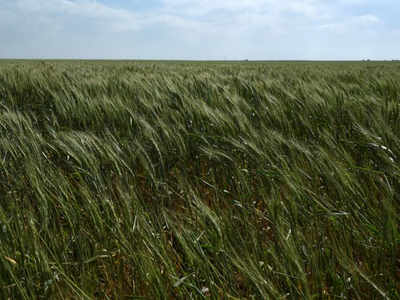- News
- Climate change is now coming for your Oreos
This story is from February 10, 2020
Climate change is now coming for your Oreos
The latest victims of climate change could be Oreos, as drenched fields across the US make the wheat that’s a key ingredient a scarcer commodity. Winter-wheat plantings fell to their lowest levels in more than a century as the grain got harder to seed. Especially the soft red winter wheat, with sowings slumping 25%, a variety that forms the base for biscuits.

A field of winter wheat is seen near Wakita, Oklahoma, US (Reuters, file photo)
NEW YORK: The latest victims of climate change could be Oreos, as drenched fields across the US make the wheat that’s a key ingredient a scarcer commodity.
Winter-wheat plantings fell to their lowest levels in more than a century as the grain got harder to seed. That was especially true for soft red winter wheat, with sowings slumping 25%. And that might be bad news for snack fans — the variety is used in the flour that forms the base for crackers, biscuits and beloved goodies including Mondelez International Inc.’s Oreos and Kellogg Co.’s Cheez-Its.
The warming atmosphere is making the spring planting season a lot wetter and a lot muddier in the Midwest. That’s pressuring farmers to abandon a strategy known as double-cropping — when the same fields get sown in the spring with soybeans and then in the fall with wheat. Forced to choose just one, growers are giving up on wheat.
Changing weather patterns are wreaking havoc on traditional agriculture calendars all over the world. For America’s breadbasket, record rainfall in the spring of 2019 resulted in planting delays that pushed harvests deeper into autumn, when farmers would want to sow winter-wheat seeds.
Winter-wheat plantings fell to their lowest levels in more than a century as the grain got harder to seed. That was especially true for soft red winter wheat, with sowings slumping 25%. And that might be bad news for snack fans — the variety is used in the flour that forms the base for crackers, biscuits and beloved goodies including Mondelez International Inc.’s Oreos and Kellogg Co.’s Cheez-Its.
The warming atmosphere is making the spring planting season a lot wetter and a lot muddier in the Midwest. That’s pressuring farmers to abandon a strategy known as double-cropping — when the same fields get sown in the spring with soybeans and then in the fall with wheat. Forced to choose just one, growers are giving up on wheat.
Changing weather patterns are wreaking havoc on traditional agriculture calendars all over the world. For America’s breadbasket, record rainfall in the spring of 2019 resulted in planting delays that pushed harvests deeper into autumn, when farmers would want to sow winter-wheat seeds.
End of Article
FOLLOW US ON SOCIAL MEDIA
